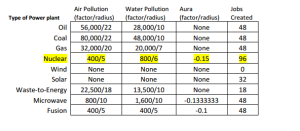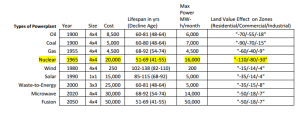I’ve got a few backlog posts, so I can say that for the time-being, I expect to post every Tuesday and Thursday. I’ve sorta impressed myself with how easily I’ve been able to write without killing myself with work or my other projects (so far). This is my Tuesday post.
Below is a
bastardizationabridged version of an older essay I once wrote. I wanted to introduce these ideas so I can call them up later with a link and a hand-wave. This post is about an idea called the Simulation Gap. The example I provide (Nuclear Power in SimCity 3000) was originally a much longer section from an essay I wrote about games as rhetoric in college, and also the basis of the presentation I made for our winning entry for Microsoft’s National “Imagine Cup” in 2012, which I’ll probably come back to in this blog sometime.
Summary
For those uninterested in justification or citation, here are the key points.
- All simulations are simplifications, and what they prioritize to precisely emulate or roughly approximate or even include in the simulation can make an argument and affect an experience.
- The “Simulation Gap” is the “gap between rule-based representation and player subjectivity.”
- The difference between the simulation’s “view” and the player’s subjective understanding of the “model” is where rhetorical power in a game [or other artifacts] lies.
- Procedural literacy is the ability to read and write procedural rhetorics, or as Bogost claims, “to craft and understand arguments mounted through unit operations represented in code”.
- One good framework to use to explore the interaction between a game and a player is “MDA” or “Mechanic-Dynamic-Aesthetic“: A game’s rules (mechanics) regarding the players fuel emergent game behaviors (dynamics) that in turn generate emergent game experiences (aesthetics).
The Simulation Gap
In software engineering, there’s a commonly-known architectural pattern known as “MVC” or “Model-View-Controller”. The model is internal logic inside of a software system, sets of rules that determine the relationship between symbols; the view is the representation, or the mapping between the computer logic to symbols and tokens that the user of the program can see and appreciate. The controller is the possible input from the user, which in turn updates the model and/or the view to the user.
The “Simulation Gap” is the “gap between rule-based representation and player subjectivity.” Ian Bogost suggests that in relation to rhetoric, “a procedural model like a videogame could be seen as a system of nested enthymemes, individual procedural claims that the player literally completes through interaction” [My source is “Procedural Rhetoric” by Bogost]. For reference, enthymeme is the technique where a proposition in a syllogism is removed, and the listener is expected to fill in the missing proposition to complete the claim or argument. Instead of mentally filling in a missing verbal proposition, the player must imagine some relationship between symbols, or interpret some unseen symbols, or input some action, in order to derive meaning and pragmatically interact with the procedural system, which in turn accepts the input, evolves the model according to whatever underlying rules are in place, and then presents the changed state to the user to further interpret and interact with. As in other rhetorical media, there is a sense of exchange between the receptive audience/player and the rhetor/system.
The difference between the simulation’s “view” and the player’s subjective understanding of the “model” is where rhetorical power in a game lies. “Meaning in videogames is constructed not through a re-creation of the world, but through selectively modeling appropriate elements of that world”. Since a simulation generally cannot perfectly mirror the complexity of its source system, and since a videogame-as-simulation prioritizes some aspects of its source system over others anyway (for economic, mechanical, ideological, or game design reasons), there is necessarily a “simulation gap” between the system and the player’s conception of the system. Players can interact with the system and explore these gaps to glean some understanding of the rules and the problem space that the game itself conveys, bringing their own understanding of a system to meet the game’s model of a system.
SimCity creator Will Wright often hints at the same concept when discussing policy “bias” inherent in SimCity games:
“Any simulation is a set of assumptions. So there is bias in any simulation, depending on how you look at it. […] First of all you have to clarify your internal model — how does a city really work? Most people, they’ll kind of roughly describe it, but they’ve never really thought in detail what the linkages are between different things. But when they’re playing a game like SimCity, which is one set of assumptions, it clarifies their own internal assumptions”.
Procedural literacy is the ability to read and write procedural rhetorics, or as Bogost claims, “to craft and understand arguments mounted through unit operations represented in code”. The following questions are identified by Bogost as the type of “reading” and “writing” that form procedural rhetorics:
What are the rules of the system?
What is the significance of these rules (over other rules)?
What claims about the world do these rules make?
How do I respond to these claims?
One other framework to use to explore the interaction between a game and a player is “MDA” or “Mechanic-Dynamic-Aesthetic“. I was introduced to this framework when I was doing design work on learning games while in college. The idea is simply that a game’s rules (mechanics) regarding the players fuel emergent game behaviors (dynamics) that in turn generate emergent game experiences (aesthetics). I might return to this framework sometime in the future.
Example: Nuclear Power in SimCity
Here are some charts demonstrating rules about “power plants” in SimCity 3000. It helps to know generally how the game is played. The first one is information available to the player (I highlighted nuclear).
This second chart shows rules that the player cannot see directly but can roughly infer through visual clues. (Aura is about an area’s prestige).
The simulation gap with regards to these energy options exists because the model has a mathematically precise idea of how to treat different power plants and their relationship to other objects in the game. The player is left to deal mainly with effects and cues to get a feel for what the model is like, determine why it reacts in the ways that it does, and respond accordingly.
These rules (mechanics) do make arguments and inform player choices (dynamics) about nuclear energy, ultimately generating an experience (aesthetic) that the player might associate with the subject. The Nuclear Power Plant is one of the most expensive power plants available, and provides the most power aside from the fictional Fusion Power Plant (available nearly a century later). Despite having among the lowest rates of pollution of all power plants, and producing the most jobs for the locals, it lowers aura (a measure used for “prosperity” or “prestige”) by the largest factor of all power plants. It also has the largest negative effect on land values for all zones. Interestingly, depriving a Nuclear Power Plant of water does not create a panic, although it does incapacitate the plant after a while. This is particularly strange, since the game breeds concerns for nuclear meltdowns without any care to how they are actually produced. This may be an example of an ‘economic’ or ‘aesthetic’ design decision, as micromanaging a Nuclear Power Plant (ex. depriving the plant of water to increase the likelihood of meltdown) does not fall within the purview of important game tasks.Understanding these rules and their significance, we should ask what kinds of assumptions these rules make.
The fourth and final question Bogost supplies when discussing procedural rhetoric literacy is, “How do I [the player] respond to these claims?”. In the original SimCity (1989), only coal and nuclear power plants exist. Maxis co-founder Jeff Braun claimed that in the original SimCity,
“we sort of tease people into thinking [nuclear power] is a good deal. It doesn’t pollute, and it generates three times as much power as a coal plant. But it will blow up, and when it does, it’s a major disaster”.
Coal plants are cheaper but produce pollution. Nuclear power plants are more expensive and cleaner, but risk meltdown. This model was reductive for various reasons: developing the game was costly and there was not a lot of capital; the personal computer was not particularly powerful; judging from Jeff Braun’s quote, there may have been an overtly political influence in the model’s logic, although this could just as easily have been a game design decision for the player to have to make a cost-benefit analysis for his city. The question still arises why coal and nuclear were the two options to appear in the game.
Maxis founder and SimCity creator Will Wright explains the game’s catastrophic attitude towards nuclear power as a game design decision:
“A lot of times we will simulate things not the way they actually work, but the way people think they work, for entertainment reasons. So in the original SimCity if a nuclear power plant caught fire, it would blow up at some point –which they don’t do. I mean, they just don’t blow up like that. But it’s because people were expecting that.”
In SimCity 3000, from what the numbers from the model of the simulation suggest nuclear power is feasible but difficult: it is clean but expensive, powerful but unpopular. The chance of catastrophe is very clearly orders of magnitude higher than it is outside of the simulation (note: is there a name for a thing being simulated, the presumed ‘real thing’?). There is a sense of a Faustian bargain in the decision to construct Nuclear Power Plants- they are available early, and are even more powerful than most of the later power plant developments, but they require constant attention and many other agents in the game respond negatively to them. Players who have played the game once may decide to wait and receive delayed gratification in the aura-boosting “Nuclear Free Zone” ordinance option and then perhaps taking advantage of the implausibly positive Fusion Power Plant. It’s unfair to claim an overt political message in SimCity’s treatment of nuclear power, but the reinforcement of particular stereotypes assumed in the audience, as well as the very particular criticisms of in-game nuclear power plants that single them out from the many other potential power sources demonstrate the hostility of SimCity’s model to nuclear power. As a reductive system, the game approaches nuclear power as a decision-making gamble.
Note: On Thursday, I’ll make a simple metaphor about fertilizer and then summarize other people’s ideas about human organization.
